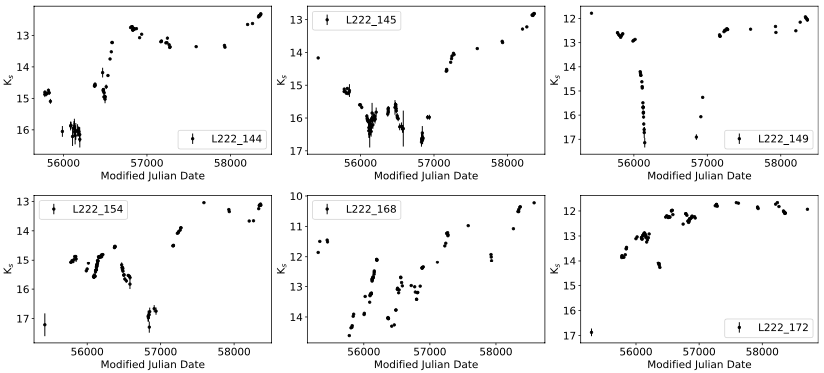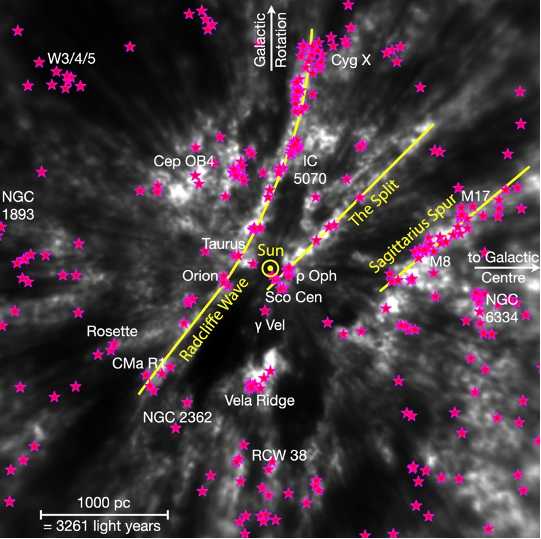The interstellar medium, white dwarfs and mass loss from red giants
(Forbrich, Kuhn, Lucas, Napiwotzki, Scicluna)
There is currently growing research activity on evolved stars and the interstellar medium in the Centre for Astrophysics. For many years group members have studied white dwarfs (Ralf Napiwotzki) and proto-planetary nebulae (Tim Gledhill, now retired), and members of the star formation group studied molecular clouds. In early 2024 Peter Scicluna, joined the group, studying the contribution of mass loss from evolved stars to the interstellar medium, and shortly before that Philip Lucas began working to understand the circumstellar matter observed in a new population of aperiodic “Dipping Giants” unexpectedly discovered in the Nuclear Disc of the Milky Way with the VVV survey.
White Dwarfs
Ralf Napiwotzki is PI of the SPY project (Napiwotzki et al., 2001, AN, 322, 411; 2020, A&A, 638, A131), a large spectroscopic search for double degenerate binary white dwarf systems. These are one of the major contenders for the progenitors of Type 1a supernovae, the other being single degenerate binary systems. Type 1a supernovae tend to have very similar luminosities and so in the late 1990s they became a very important standard candle that can be used over cosmological distances to measure the rate of expansion of the universe. This led to the discovery that the expansion of the universe is accelerating, interpreted as the effect of the so-called “cosmological constant”, i.e. a source of energy that overcomes gravity on large scales. The SPY survey targeted 689 DA-type white dwarfs with the UVES echelle spectrograph on the Very Large Telescope in Chile. By obtaining two or more radial velocities for these stars, the team was able to identify 39 double degenerate systems where the velocity changed due to a massive unseen companion. Only 4 of these were previously known. 20 of the 39 are double lined systems and 19 are single-lined systems.
Mass Loss from Evolved Stars
Asymptotic Giant Branch (AGB) stars are the dominant source of chemically enriched matter that is returned to the interstellar medium at the end of stellar evolution, the other major source being supernovae. This is a key part of the life cycle of the elements.
Peter Scicluna is PI of the Nearby Evolved Stars Survey (NESS). This survey with the James Clerk Maxwell Telescope in Hawaii and the Atacama Pathfinder Experiment in Chile, is observing a complete sample of mass-losing AGB stars within 3 kpc to measure their rates of dust ejection into the interstellar medium, the dust to gas ratios, and the 13CO/12CO ratios. These observations will lead to a fuller understanding of the process as a function of the evolutionary sub-stages within the AGB.
Philip Lucas is leading the investigation of the newly discovered Dipping Giant population (Lucas et al., 2024, MNRAS, 528, 1789). These are non-pulsating late K-type to early M-type giant stars that are strongly clustered in the Nuclear Stellar Disc of the Milky Way, a region of very high stellar density that is approximately coincident with the Central Molecular Zone (though the relation between the two is unknown). These were discovered by the VISTA Variables in the Via Lactea survey (Minniti et al., 2010). They
are non-pulsating stars, likely to be AGB stars, that show long-lasting, asymmetric and apparently aperiodic dips in their near infrared light curves that can be many magnitudes deep, such that they can fade below the VVV detection limit. Due to their Galactic location, they are hidden from view in visible light. The Nuclear Stellar Disc is thought to be a region of high metallicity, i.e. including many stars of super-solar metallicity. Mid-infrared data from the Spitzer Space Telescope (the GLIMPSE-II and MIPSGAL surveys) shows no large mass of cold dust, leading to the suggestion that the dips are due to dust puffs along the line of sight, similar to those seen in R Cor Bor stars, a rare class of yellow supergiants. In this scenario, it is suggested that the radiatively driven dust puffs are linked to the high metallicity of the region. This can be expected to enhance dust production in cooler parts of the upper atmosphere and therefore increase the opacity. An alternative possibility is that the dips are related to an irregular distribution of matter spread around the orbit of a companion body. That scenario is the likely cause of Long Secondary Periods that are seen in some pulsating Mira variables. It would predict that the dips are periodic (possible P>10 yr), though it does not explain the spatial clustering.

Molecular and Atomic Clouds
(Jan Forbrich and Mike Kuhn)
We also study molecular clouds as the birthplaces of stars and drivers of galaxy evolution. Utilising wideband upgrades to radio telescopes, we are studying the resolved dust and molecular emission of hundreds of molecular clouds in the Andromeda Galaxy, placing such studies on the same footing as local molecular cloud studies. In the SMA ADAMS project (SMA Andromeda Dust and Molecular gas Survey) we are using the newly upgraded Submillimeter Array (SMA), complemented by a survey of high-mass star formation in the Andromeda Galaxy conducted with the Very Large Array (VLA) in the centimetre waveband, and by a related optical spectroscopic survey conducted with MMT/Hectospec.
We also research the large-scale distribution of dust and gas in the Milky Way (see Figure 2), as part of work to map the 3D locations of star-forming regions in the Solar neighbourhood and investigate their association with our Galaxy's spiral structure. This includes analysing the connections between young stellar populations and maps of Galactic gas and dust and examining the kinematics and orbits of young stars within the Galactic disc. Gaia has given a significant boost to this work.
